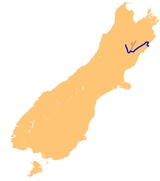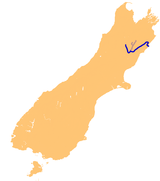
Clarence River, New Zealand
Encyclopedia

South Island
The South Island is the larger of the two major islands of New Zealand, the other being the more populous North Island. It is bordered to the north by Cook Strait, to the west by the Tasman Sea, to the south and east by the Pacific Ocean...
of New Zealand
New Zealand
New Zealand is an island country in the south-western Pacific Ocean comprising two main landmasses and numerous smaller islands. The country is situated some east of Australia across the Tasman Sea, and roughly south of the Pacific island nations of New Caledonia, Fiji, and Tonga...
. It is 160 kilometres long.
For its first 50 kilometres, the river runs in a generally southeastern direction. It then turns northeast, running down a long straight valley between the Inland and Seaward Kaikoura Ranges
Kaikoura Ranges
The Kaikoura Ranges are two parallel ranges of mountains in the northeast of the South Island of New Zealand.Formed along New Zealand's Marlborough Fault System, they can be seen as the northernmost extension of the Southern Alps in the South Island....
. At the end of the Seaward Kaikouras, the river meanders through undulating hill country before draining into the Pacific Ocean
Pacific Ocean
The Pacific Ocean is the largest of the Earth's oceanic divisions. It extends from the Arctic in the north to the Southern Ocean in the south, bounded by Asia and Australia in the west, and the Americas in the east.At 165.2 million square kilometres in area, this largest division of the World...
near the town of Clarence
Clarence, New Zealand
Clarence is a small town in Marlborough, in the South Island of New Zealand. It was named after King William IV of the United Kingdom, who prior to his accession was Duke of Clarence....
.
A large part of the river is within the boundaries of Molesworth Station
Molesworth Station
Molesworth Station is New Zealand's largest farm, at over 1,800 km², and supports the country's biggest herd of cattle. It also hosts government science programs, such as research into bovine tuberculosis and related research into possums....
.
Northern tributaries along the middle segment of Clarence River (e.g., Mead Stream, Dee Stream, Muzzle Stream) cut through an uplifted and rotated block of limestone
Limestone
Limestone is a sedimentary rock composed largely of the minerals calcite and aragonite, which are different crystal forms of calcium carbonate . Many limestones are composed from skeletal fragments of marine organisms such as coral or foraminifera....
and marl
Marl
Marl or marlstone is a calcium carbonate or lime-rich mud or mudstone which contains variable amounts of clays and aragonite. Marl was originally an old term loosely applied to a variety of materials, most of which occur as loose, earthy deposits consisting chiefly of an intimate mixture of clay...
deposited from the late Cretaceous
Cretaceous
The Cretaceous , derived from the Latin "creta" , usually abbreviated K for its German translation Kreide , is a geologic period and system from circa to million years ago. In the geologic timescale, the Cretaceous follows the Jurassic period and is followed by the Paleogene period of the...
through the Paleocene
Paleocene
The Paleocene or Palaeocene, the "early recent", is a geologic epoch that lasted from about . It is the first epoch of the Palaeogene Period in the modern Cenozoic Era...
and middle Eocene
Eocene
The Eocene Epoch, lasting from about 56 to 34 million years ago , is a major division of the geologic timescale and the second epoch of the Paleogene Period in the Cenozoic Era. The Eocene spans the time from the end of the Palaeocene Epoch to the beginning of the Oligocene Epoch. The start of the...
(75-45 million years ago). Exposures of this limestone -- the Amuri Limestone -- provide some of the most complete records for this time interval of Earth's history. They have provided important insights to our understanding of the Paleocene-Eocene Thermal Maximum
Paleocene-Eocene Thermal Maximum
The most extreme change in Earth surface conditions during the Cenozoic Era began at the temporal boundary between the Paleocene and Eocene epochs . This event, the Paleocene–Eocene Thermal Maximum , was associated with rapid global...
(PETM), Eocene Thermal Maximum 2
Eocene Thermal Maximum 2
Eocene Thermal Maximum 2 , also called H-1 or the Elmo event, was a transient period of global warming that occurred approximately 53.7 million years ago...
(ETM-2), and other Paleogene hyperthermal events.

